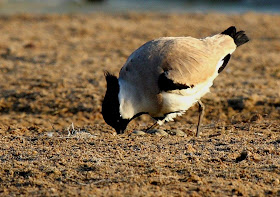Wetlands offer a range of foods to birds, and the monsoon is a fantastic season to observe birds getting their goodies. In this entry, two species are shown doing what they do best.


 Asian Openbills are super-specialized in their food habits - they almost exclusively eat the large snails associated with flooded rice paddies. It is believed that this stork species has increased in numbers and spread closely following the increase of rice cultivation in Asia. Above, you can see a stork getting hold of a nice-sized snail, prising open the snail's lid, and pulling out the meaty snail for a doubtlessly yummy early morning snack.
Asian Openbills are super-specialized in their food habits - they almost exclusively eat the large snails associated with flooded rice paddies. It is believed that this stork species has increased in numbers and spread closely following the increase of rice cultivation in Asia. Above, you can see a stork getting hold of a nice-sized snail, prising open the snail's lid, and pulling out the meaty snail for a doubtlessly yummy early morning snack.
 The Little Heron (variously also referred to as the Green Heron and Little Green Heron) is not common in the inland areas of northern India. A neat, compact little heron, this species is an expert fisherbird. Above, a heron catches and hangs on to a fish beside a rice field - good start for a breakfast that will no doubt include many more fishies.
The Little Heron (variously also referred to as the Green Heron and Little Green Heron) is not common in the inland areas of northern India. A neat, compact little heron, this species is an expert fisherbird. Above, a heron catches and hangs on to a fish beside a rice field - good start for a breakfast that will no doubt include many more fishies.(Photograph information: Asian OpenbillLs: 8 Aug 2009, Mainpuri district; Little Heron: 5 Aug 2009, Bhadohi district.)
 A woman in central Pratapgarh district throws handfuls of ash from the kitchen stove on ripening rice. Many farmers in Uttar Pradesh still limit the use of chemical pesticides, or continue using traditional materials, like ash, alongside chemical pesticides to control insect pests on rice. A Zitting Cisticola sat undeterred (not visible here), presumably near its nest, as a cloud of ash fell on and around it - now that would have been an excellent photo to get!
A woman in central Pratapgarh district throws handfuls of ash from the kitchen stove on ripening rice. Many farmers in Uttar Pradesh still limit the use of chemical pesticides, or continue using traditional materials, like ash, alongside chemical pesticides to control insect pests on rice. A Zitting Cisticola sat undeterred (not visible here), presumably near its nest, as a cloud of ash fell on and around it - now that would have been an excellent photo to get!


















































